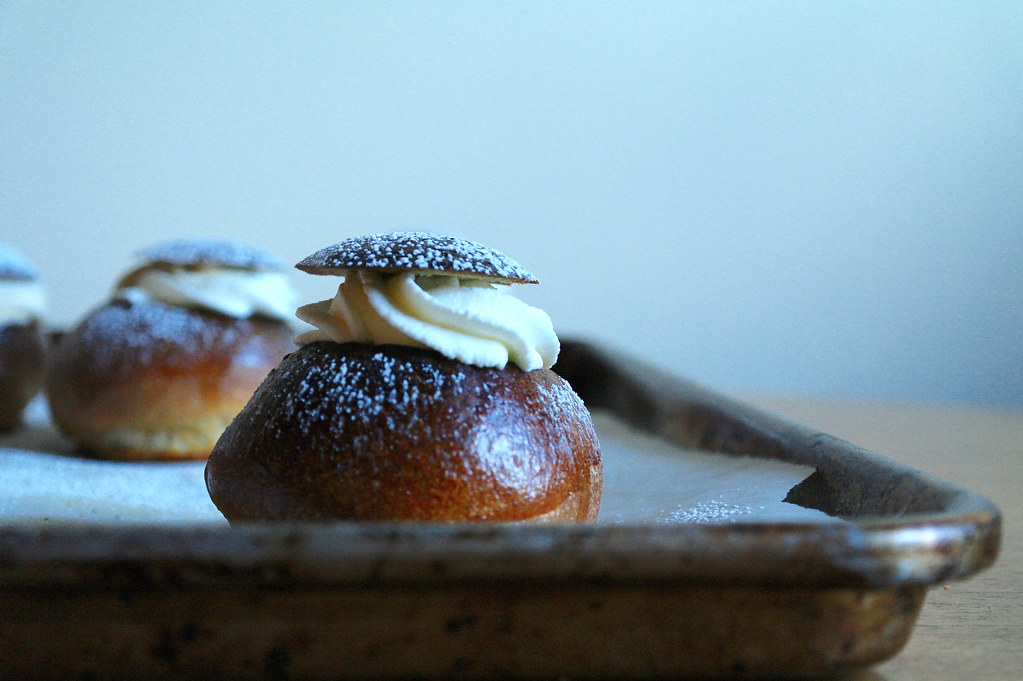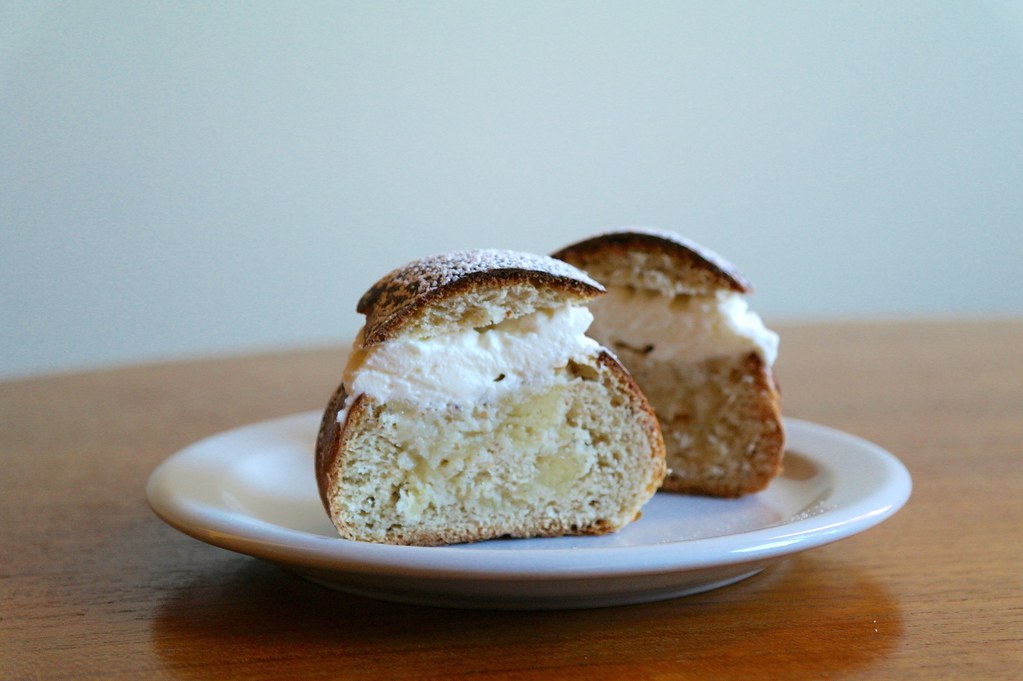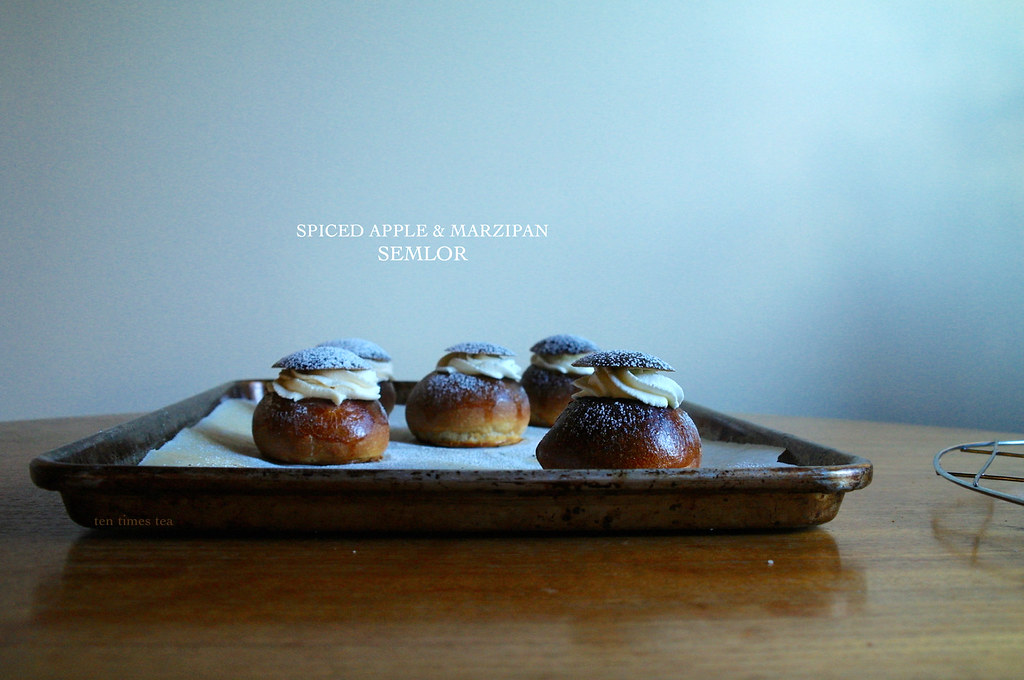
 I have been doing some thinking since last week.
I have been doing some thinking since last week.
Last week I talked about how a bread that I had put in the fridge after being fully risen then collapsed and never managed to rise completely. I have a new hypothesis now, one which explains that observation, some of the experiments I did with this dough, and also underlies how there is no need for alarm about collapsing your bread dough (unless you’re me).
After the first rise of this dough, I put it in the fridge, fully risen, until the next day. The next day it was perfectly fine–it hadn’t collapsed at all and the dough was quite tough and springy. This is observation #1.
Observation #2 is that my sourdough breads always seem to turn out very sour. I don’t feed the sourdough starter too often and all the acidity seems to build up.
I also tend to find that my sourdough can only rise so much (observation #3). It can never really make it to a full third rise. I had always vaguely ascribed this to the rabid yeast-y creatures having chewed everything up even though my sourdough always rises so slowly, contrarily indicating that the yeast population remains low in abundance and pretty sluggish.
I think that observation #2 (acidity) can explain my observation #3. I think it is the rising acidity, not the rabid action of the yeast which can break down the protein content of the dough, eventually destroying the the gluten structure. Thus, as with observation #1, a new dough (on its first rise) can stand being refrigerated as the protein structure is sufficient to maintain its form. A dough that has been weakened (on its second rise) may not be able to maintain its form upon refrigeration. And even when subsequently given a long time to rise afterwards, it will only be able to rise so much due to the lower gluten content.
As additional support, one time (this was in junior high school so I can look back and laugh at my bread-naivety) I wanted to make a lemon bread and I decided to do this by putting a lot of lemon juice in. There was no gluten structure at all! It rose in a very flat and sloppy manner.
I’m not sure if any of this is right, but it made sense in my head. I might come to a different conclusion later though.
The (for now) conclusion: I need to be careful about how long I keep my bread dough around! I should also feed my sourdough starter more often…maybe this will help? And there is no real concern about collapsing your bread dough if you refrigerate it fully risen. I think it should be quite alright!
Ah, back to the issue of semlor. When I first saw them, I kept on thinking of these magnificent creampuffs from beta5. Now when I see creampuffs the association will go in the other direction and I will think of semlor because they are lovely.
I brainstormed a bit with Claire from This is not a pie after seeing her wonderfully puffy semlor. She was considering a delicious-sounding poppy seed cream, while I mused vaguely (not really certain about how they would play in) about apples. After seeing these raspberry semlor from My Danish Kitchen, jam also started playing a role….
The classic marzipan filling. When I first made it I wasn’t exactly convinced–it is grated marzipan and the torn up bread from the inside of the buns, moistened until soft. However, once it is in the bun, it’s perfect. I suppose because the filling is partly made out the bun, it is quite compatible (like deviled eggs), with the texture being a softer, sweeter extension of the bun.
Here is the spiced apple filling that I made. I really like it. I mixed together some warm apple with the marzipan and the marzipan melts a bit and the whole thing is a lovely mess when eaten warm.
I also folded some cloudberry jam into the whipped cream (in the style of the cloudberry cream from The Nordic Cookbook). It was a bit tart and sweet. I intended to pipe it on top of the classically filled semlor, but I accidentally ended up piping it over the apple semlor (and the plain cream over the classic semlor). The classic ended up staying classic, and with all the flavour from the apple, I didn’t notice anything at all from the cloudberry cream. I think, however, it might be nice to add some tartness to the classic semlor. However, considering that the buns are sourdough, there is plenty of tartness already.
 While it is not pictured, I did make a third sort of semlor, filled with ricotta and ligonberry preserves.
While it is not pictured, I did make a third sort of semlor, filled with ricotta and ligonberry preserves.
In making the almond paste, I took some inspiration from The Great Scandinavian Baking Book because it didn’t use any egg white as almond paste typically does (and I prefer to avoid eating raw eggs when I can). I think the almond paste worked out very well–I suppose you just have to be careful to keep it at room temperature and it probably will not last as long. (I also read here that corn syrup is another alternative to egg whites!)
I’m bringing this as an awfully awfully last-minute contribution to Fiesta Friday, kindly hosted by Angie and this week hosted by Steffi of Ginger & Bread and Andrea from Cooking With a Wallflower.
You can find an updated recipe here!
spiced apple and marzipan semlor
Enough dough for 16 semlor. The filling quantities make enough for 4 semlor. I’m calling it marzipan because I think “spiced apple and marzipan” sounds nicer than “spiced apple and almond paste”, but perhaps almond paste is a better description from what I understand of the consistency difference between marzipan and almond paste.
cardamom and spelt buns
The dough is adapted from The Nordic Cookbook by Magnus Nilsson.I used half the dough to make 8 semlor.
sponge
100 g sourdough starter
100 g spelt flour
100 g milk
dough
120 mL milk
80 g butter
1 tbsp (5-6 g) ground cardamom
1 tsp (2 g) kosher salt
100 g sugar
2 eggs
500 g flour
Mix together the sponge and let sit overnight until well risen.
The next day, heat the milk and butter together in a small saucepan until the butter melts. Transfer to a bowl and let cool. Whisk in the remaining ingredients apart from the flour. Add the sponge and around 400 g of the flour and mix until you form a cohesive dough. Add flour as needed until you have a dough that is tacky but not sticky.
Cover and let rise fully, which took around eight hours for me.
Take half the dough and divide into eight pieces. Roll each into a ball and place on a parchment lined tray. Cover loosely with plastic wrap and let rise until nicely puffy which took a few hours in a warm place for me.
Preheat the oven to 400F.
Brush the buns with a beaten egg. Bake for 10 minutes, turn down the temperature to 350F and bake for another 5.
Remove and let cool on a wire rack.
filling & assembly
almond paste
Adapted from The Great Scandinavian Baking Book by Beatrice Ojakangas.
90 g ground almonds
60 g icing sugar
10-15 mL heavy cream
Combine the almonds and icing sugar in the bowl of a food processor. Mix. Add the cream bit by bit until a soft dough is just formed. Chill in the fridge.
classic almond filling
To fill 4 buns, or 1/4 of the dough. From The Nordic Cookbook by Magnus Nilsson.
1/3 -1/2 of the almond paste
milk
60 mL 36% m.f. cream
2 tbsp cloudberry preserves, optional
icing sugar
Cut the tops off of four of the buns. Hollow out the breads by pulling out the insides. Break apart the bread innards into small pieces. Grate around 1/3 – 1/2 of the almond paste using the large holes of a box grater into the bread innards. Add a dash of milk as needed, just to moisten. Mix together. Pack into the hollowed out buns.
Whip the cream until thick and just stiff.
If desired, flavour the cream with the cloudberry preserves. Press the preserves through a sieve to remove the seeds. Stir one spoonful of cream into the strained preserves. Fold into the cream. Quickly (as the whipped cream begins to collapse a bit, which is accelerated by the jam) place into a piping bag fitted with a star tip and pipe a generous amount on the top of each bun.
Top each bun with the piece of bread you previously sliced off. Dust with icing sugar.
spiced apple and marzipan filling
To fill 4 buns, or 1/4 of the dough.
1 large apple
1/2 tsp ground cinnamon
1/2 tsp ground cardamom
dash of grated nutmeg and pinch of ground cloves
1/3 of the almond paste.
60 mL 36% m.f. cream
icing sugar
Core the apple and chop into small pieces. Place in a saucepan and add enough water to partially cover the apples. Add in the spices. Bring to a simmer and cook until the water is mostly gone and the apples are tender.
Grate around 1/3 of the almond paste using the large holes of a box grater into the spiced apples. Stir to combine; if the apples are still warm, the almond paste will melt a bit.
Cut the tops off of four of the buns. Hollow out the breads by pulling out the insides. Fill each bun with 1/4 of the filling.
Whip the cream until thick and just stiff. Put into a piping bag fitted with a star tip and quickly (as the cream begins to collapse when it is in the piping bag) and pipe a generous swirl on top of each bun. Place the small round of bread you previously sliced off the top of each back on top of the cream.
Dust with icing sugar.
I also quite liked a ricotta and ligonberry filling that I tried. Fill the bottom of the bun with a good couple spoonfuls of ricotta (I had flavoured it with a bit of lavender for another purpose), then a spot of ligonberry preserves.








These are beautiful!
LikeLiked by 1 person
Thank you! I love getting the chance to use a swirly piping tip (I just don’t like cleaning it out!)
LikeLiked by 1 person
That looks great
LikeLiked by 1 person
Aww, thanks! I concur, semlor are very great 🙂
LikeLiked by 1 person
These sound absolutely delicious!! I will have to try 🙂 such good inventive baking
LikeLiked by 1 person
Thank you Claire! It’s so much fun…so many possibilities! 🙂
LikeLiked by 1 person
Simply beautiful and delicious.
LikeLiked by 1 person
Thank you Suzanne! There is something about a filled bun with plenty of whipped cream…
LikeLike
Your musings about sourdough are very helpful – I may have excess acidity too, so I will try your remedy of feeding it more often. Your buns look fantastic.
LikeLiked by 1 person
Sorry Hilda, a very, very lengthy and uncertain response upcoming:
I’m thinking feeding more often might help, but I’m not sure. I had read somewhere (I think it might have been Peter Reinhart’s the Bread Baker’s Apprentice) that he doubles his sourdough starter the day before if he wants a more acidic bread, and triples his sourdough starter if he wants a less acidic bread. I don’t feed my starter very often at all and in the past few years my bread has been getting very sour, so I thought the feeding schedule might be the cause. However, I’m not sure how to rationalize how feeding more/more often might help. It would dilute the acid that has built in up in the starter, but I don’t know if it helps in terms of keeping down the acidic bacteria population. Maybe bacteria can thrive better than the yeast when times are tough (i.e. the starter hasn’t been fed in months!) and so their population grows more when feedings are less frequent? Anyways, I’ll try to do some reading sometime to see if anyone clever has gotten onto the topic 🙂
LikeLike
I’ve never heard the term semlor before. They are just beautiful and the apple looks so delicious. I am so glad you revisited your bread difficulty. It’s good to see what works and what doesn’t always work.
LikeLiked by 1 person
I find Nordic nomenclature very confusing! Looking off the Nordic Cookbook, semlor are known by a variety of terms in different countries. I seem to spend a lot of time with bread difficulties (lately I keep thinking about bread-things before I go to sleep so it’s a wonder I haven’t been dreaming about bread). I do agree though, revisiting difficulties is useful! 🙂 Thank you Julie!
LikeLiked by 1 person
May your dreams be filled with perfectly baked sourdough loaves tonight! 🙂
LikeLiked by 1 person
Thank you Julie–I hope so! (And if dreams of bread are similarly appealing to you, I wish you the same 🙂 )
LikeLiked by 1 person
These look so elegant!
LikeLiked by 1 person
Thank you Nell! Haha, I would attribute the elegance to the small hat that is cut off the top of the bun… it seems a bit purposeless (I kept on wanting to just eat them as I was putting the semlor together), but it wouldn’t be a semla with it!
LikeLike
Looks lovely, Tea! 🙂 when i saw it – it looked like swedish buns 🙂 it does have some scandinavian influence to it 🙂
LikeLiked by 1 person
I did not know about these buns until this year (after seeing them in blogs and then in a couple of cookbooks). I’m so glad I discovered semlor as I really love them! 🙂 Thank you!
LikeLiked by 1 person
👌🏼👍🏼
LikeLiked by 1 person
They are adorable! I cannot make up my mind which filling I like best …
Happy FF!
LikeLiked by 1 person
The fillings all have their merits (and now I have ideas for more fillings!) Happy FF and thank you for cohosting this week Ginger! 🙂
LikeLiked by 1 person
Can’t wait on your next ideas! 🙂
LikeLiked by 1 person
I can’t believe I didn’t see this post until now! I am getting a little homesick reading about semlor and amazingly I have NEVER even thought about putting another filling in than the classic one. This is a true aha experience! he he They look absolutely perfect and oh do I wish I had one now! 🙂
LikeLiked by 1 person
Oh, I did not know you were from Scandinavia Petra! I only just discovered semlor recently, so I didn’t have any fond memories of the classic filling… if I did, I would never think of changing the filling either!
LikeLiked by 1 person
I think your filling looks delicious! It just stunned me! ha ha I used to heat milk and fill a deep bowl by about half, put my semla there and eat it like that. I am from Sweden and this is one of the things I really miss 🙂
LikeLiked by 1 person
I read about that method in the Nordic Cookbook! The author was not a fan, but I think it sounds like a delicious and comforting way to eat semlor. There is one left, so that will be my breakfast for tomorrow 🙂 I hope you come across some semlor where you live now!
LikeLike
Beautiful idea!! Looks delectable!
LikeLiked by 1 person
Thank you Ana! I was really taken with the semlor I saw on various blogs–they all look so pretty!!
LikeLiked by 1 person
The Swedes are constantly coming up with ideas of how to change their traditional semlor and I love your ideas! You can’t go wrong with sweet cardamom bread and cream, that’s all I can say!
LikeLiked by 1 person
I absolutely agree! An infallible combination of cream and cardamom bread is endlessly versatile! 🙂
LikeLiked by 1 person
Great recipe idea!
LikeLiked by 1 person
Thank you! I’ve been obsessed with the Great Scandinavian Baking Book lately… this is just one of the many things I want to tackle out of it 🙂 !
LikeLike
I love anything with marzipan, rather marzipan itself 🙂 This looks so delicious and gorgeous!
LikeLiked by 1 person
I haven’t really eaten marzipan before this, but now I agree with you… I love marzipan as well! Thank you Freda 🙂
LikeLiked by 1 person
🙂
LikeLiked by 1 person
Still haven’t tried semlor! I really must! They look and sound superb. Not sure where to find them here, though. Someone told me Ikea has them, but I’ve never seen them there. I guess if I really want to try them, I need to make them myself. Saving this recipe, thanks! XOXO
LikeLiked by 1 person
Ikea really does have everything now! I think they’re worth making because even if you don’t fill the buns, any sweet enriched and cardamom-flavoured bread will already be delicious on its own! Thanks Angie 🙂 xx
LikeLike
These look so delicious Laurie! Love the marzipan and apple filling… your sourdough buns look great! I’m now very curious about semlor and sourdough… hmmm. And yum. Thank you for sharing such an interesting recipe! 🙂
LikeLiked by 1 person
Thanks Lili! I was happy with both the fillings, but I really did like the apple one 🙂 🙂 I am still struggling to get along with the sourdough starter at times, but sourdough-spelt-semla is alliteration too lovely to ignore!
LikeLiked by 1 person
🙂 Nice. Cooking with alliteration sounds yummy 🙂 Going to keep that in mind and maybe also the idea of trying to do a sourdough one day… hmm…
LikeLiked by 1 person
I think there are plenty of “S” flavours, so sourdough is indeed the way to go! 🙂
LikeLiked by 1 person
🙂
LikeLiked by 1 person
These are beautiful Laurie and so delicate. Beautiful pictures too. I can’t wait to try them! 🙂
LikeLiked by 1 person
Thank you Linda! They are delicate and hefty at the same time (must be all the cream!). And of course, they are plenty of fun to make 🙂
LikeLike